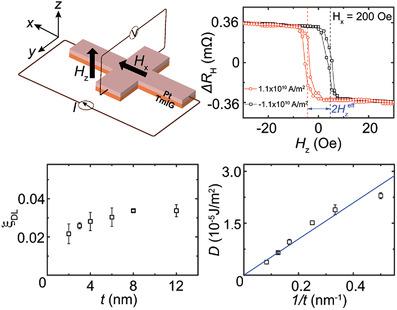当前位置:
X-MOL 学术
›
Adv. Electron. Mater.
›
论文详情
Our official English website, www.x-mol.net, welcomes your
feedback! (Note: you will need to create a separate account there.)
Spin-Orbit Torque and Interfacial Dzyaloshinskii–Moriya Interaction in Heavy Metal/Ferrimagnetic Insulator Deposited by Magnetron Sputtering
Advanced Electronic Materials ( IF 5.3 ) Pub Date : 2021-10-15 , DOI: 10.1002/aelm.202100590 Zhixiang Ye 1 , Zhiren Chen 1 , Zehan Chen 1 , Wei Jia 1 , Tenghua Gao 2, 3 , Lin Liu 1 , Hongnan Zheng 1 , Qi Zeng 1 , Qiuning Wang 1 , Ning Wang 1 , Boyuan Xiang 1 , Tao Lin 1 , Mingxia Qiu 1 , Shunpu Li 1 , Ji Shi 4 , Zhipeng Hou 5, 6 , Kazuya Ando 2, 3, 7 , Hongyu An 1
Advanced Electronic Materials ( IF 5.3 ) Pub Date : 2021-10-15 , DOI: 10.1002/aelm.202100590 Zhixiang Ye 1 , Zhiren Chen 1 , Zehan Chen 1 , Wei Jia 1 , Tenghua Gao 2, 3 , Lin Liu 1 , Hongnan Zheng 1 , Qi Zeng 1 , Qiuning Wang 1 , Ning Wang 1 , Boyuan Xiang 1 , Tao Lin 1 , Mingxia Qiu 1 , Shunpu Li 1 , Ji Shi 4 , Zhipeng Hou 5, 6 , Kazuya Ando 2, 3, 7 , Hongyu An 1
Affiliation

|
Ferrimagnetic insulators (FMIs) have abundant advantages for the application in spintronic devices, which have attracted intensive studies. However, in most previous studies on heavy metal (HM)/FMI bilayers, the FMI layers are deposited by pulsed laser deposition (PLD), and the HM layers are deposited by magnetron sputtering. This will cause the interfacial contamination due to the inevitable vacuum breaking, and then significantly affect the spin-orbit torque (SOT) generation and the Dzyaloshinskii–Moriya interaction (DMI) in the HM/FMI bilayers. In this work, the SOT and DMI in the HM/FMI bilayers deposited by magnetron sputtering without vacuum breaking are studied. The successful fabrication of the Tm3Fe5O12 (TmIG) layer, a typical FMI, with good crystallinity and perpendicular magnetic anisotropy (PMA) by magnetron sputtering is first demonstrated. Then by systematically varying the TmIG thickness, the SOT and DMI in the Pt/TmIG bilayers are studied. It is shown that the effective spin Hall angle in the Pt/TmIG bilayers is much larger than most previously reported values. It is further demonstrated that the DMI constant scales linearly with the inverse of the TmIG thickness, indicating the interfacial origin of the DMI. The study provides a piece of information for the basic understandings of the SOT and DMI in the HM/FMI bilayers.
中文翻译:

磁控溅射沉积重金属/亚铁磁绝缘体中的自旋轨道扭矩和界面 Dzyaloshinskii-Moriya 相互作用
亚铁磁绝缘体(FMI)在自旋电子器件中的应用具有丰富的优势,引起了广泛的研究。然而,在之前关于重金属 (HM)/FMI 双层的大多数研究中,FMI 层是通过脉冲激光沉积 (PLD) 沉积的,而 HM 层是通过磁控溅射沉积的。由于不可避免的真空破坏,这将导致界面污染,然后显着影响 HM/FMI 双层中的自旋轨道扭矩 (SOT) 产生和 Dzyaloshinskii-Moriya 相互作用 (DMI)。在这项工作中,研究了在不破坏真空的情况下通过磁控溅射沉积的 HM/FMI 双层中的 SOT 和 DMI。Tm 3 Fe 5 O 12的成功制造(TmIG) 层是一种典型的 FMI,具有良好的结晶度和垂直磁各向异性 (PMA) 的磁控溅射。然后通过系统地改变 TmIG 厚度,研究 Pt/TmIG 双层中的 SOT 和 DMI。结果表明,Pt/TmIG 双层中的有效自旋霍尔角远大于大多数先前报道的值。进一步证明 DMI 常数与 TmIG 厚度的倒数成线性比例,表明 DMI 的界面起源。该研究为 HM/FMI 双层中的 SOT 和 DMI 的基本理解提供了一条信息。
更新日期:2021-10-15
中文翻译:

磁控溅射沉积重金属/亚铁磁绝缘体中的自旋轨道扭矩和界面 Dzyaloshinskii-Moriya 相互作用
亚铁磁绝缘体(FMI)在自旋电子器件中的应用具有丰富的优势,引起了广泛的研究。然而,在之前关于重金属 (HM)/FMI 双层的大多数研究中,FMI 层是通过脉冲激光沉积 (PLD) 沉积的,而 HM 层是通过磁控溅射沉积的。由于不可避免的真空破坏,这将导致界面污染,然后显着影响 HM/FMI 双层中的自旋轨道扭矩 (SOT) 产生和 Dzyaloshinskii-Moriya 相互作用 (DMI)。在这项工作中,研究了在不破坏真空的情况下通过磁控溅射沉积的 HM/FMI 双层中的 SOT 和 DMI。Tm 3 Fe 5 O 12的成功制造(TmIG) 层是一种典型的 FMI,具有良好的结晶度和垂直磁各向异性 (PMA) 的磁控溅射。然后通过系统地改变 TmIG 厚度,研究 Pt/TmIG 双层中的 SOT 和 DMI。结果表明,Pt/TmIG 双层中的有效自旋霍尔角远大于大多数先前报道的值。进一步证明 DMI 常数与 TmIG 厚度的倒数成线性比例,表明 DMI 的界面起源。该研究为 HM/FMI 双层中的 SOT 和 DMI 的基本理解提供了一条信息。











































 京公网安备 11010802027423号
京公网安备 11010802027423号